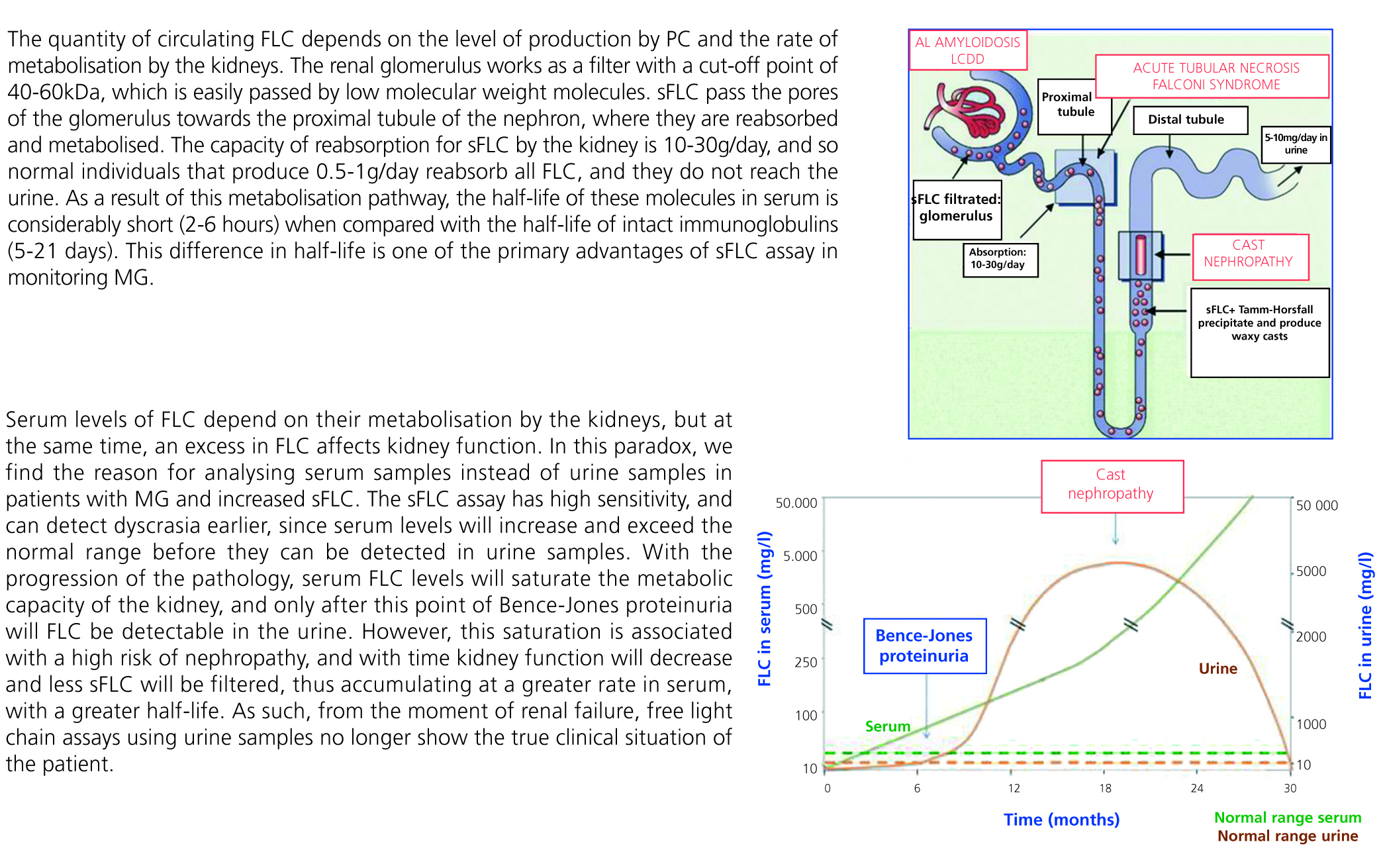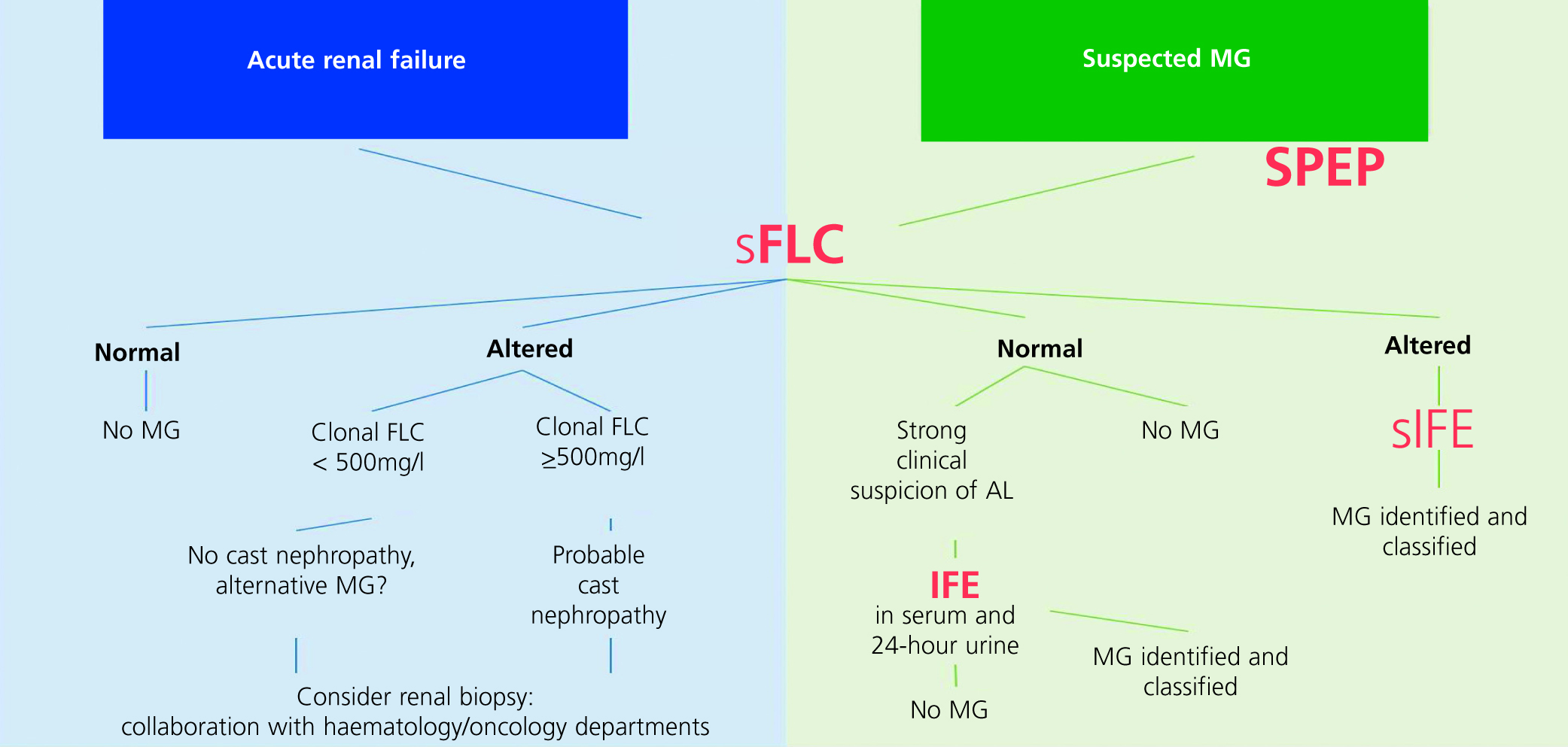Monoclonal gammopathies (MG) are blood dyscrasias that result from a neoplastic process in plasma cell (PC) clones, and are usually associated with an elevated production of a monoclonal protein (MP). This paraprotein can be an intact immunoglobulin or a light chain (LC). The immunoglobulins are composed of an identical pair of heavy chains joined to two identical kappa (κ) or lambda (λ) LC. The heavy and light chains are produced separately, and are later joined and secreted into the bloodstream. In order to ensure correct conformation of the immunoglobulins, PC produce an excess of LC, whose surplus is secreted along with the completed immunoglobulins. In this manner, 40% of LC are found free in the serum, not joined to heavy chains.1 These serum free light chains (sFLC) have a different conformation: κFLC present as 25kDa monomers, whereas λFLC form 50kDa dimers.
DIAGNOSING MONOCLONAL GAMMOPATHIES
The diagnosis of MG is based on detecting the circulating paraprotein. Serum protein electrophoresis (SPE) is the most commonly used technique for measuring monoclonal bands, but its sensitivity is limited: it is incapable of detecting MP at concentrations <400mg/l, levels that are frequently observed in cases of Bence-Jones (BJ) or light chain multiple myeloma (BJMM).2 Immunofixation electrophoresis (IFE) is a more sensitive technique for characterising the type of MP but not to quantify it, and therefore it is of limited application during the MG follow-up. Both urine electrophoresis and immunofixation are more sensitive than their equivalents in serum samples1,4; however, they are affected by the renal function of the patient, which is their primary disadvantage (Figure 1). Nephelometric techniques are the most precise and sensitive analytical methods available, but they do not make the distinction between monoclonal and polyclonal backgroud. A recent addition to the last techniques has been the sFLC assay, which allows for measuring sFLC and determining monoclonality by establishing the ratio of κvs λsFLC.2 This assay allows the detection of κFLC and λFLC separately using polyclonal antibodies produced in sheep that specifically recognise epitopes in the constant region of LC that are hidden in intact immunoglobulins, but are exposed in sFLC.1 The sFLC assay is the most sensitive assessment technique currently available. However, no technique can provide by itself a diagnosis of the various types of MG, and so they must be used together in order to provide a high sensitivity in the diagnosis.5
For the first time, sFLC assay allowed for measuring normal serum levels and determining a reference range for normal subjects. The normal range of κFLC is 3.3-19.4mg/l, and the normal range for λFLC is 5.7-26.3mg/l, with a normal interval for the κ/λsFLC of 0.26-1.65.6 Using this range in a retrospective study, Bradwell demonstrated that 100% of patients with BJMM have an altered κ/λratio, suggesting monoclonality.7 In the field of MG, sFLC assay has shown a greater sensitivity for detecting the monoclonal component, with special relevance in non-secretory MM, in which it is now possible to measure and monitor MP without having to recurre to invasive techniques, and in the case of AL amyloidosis, where international guidelines recommend measuring sFLC as part of the diagnostic process.8,9 Additionally, measuring sFLC at the moment of diagnosing MM and other MG takes on a role in prognosis and will provide a valuable baseline value for monitoring the patient during treatment.8,10 Recently, Katzmann performed a study with 1877 patients with MG, showing that a higher sensitivity for diagnosis could be achieved for the majority of malignant MG using a protocol of serum analyses (SPE + sFLC + sIFE). Based on their results, these authors proposed replacing IFE in 24-hour urine samples with the sFLC assay.11 This simple algorithm allows for orientating the diagnosis towards cast nephropathy (Figure 2). In a similar manner, the International Myeloma Working Group recommended using a combination of SPE, sFLC, and sIFE for tracking MG, and suggested that the sFLC assay could substitute IFE in 24-hour urine samples. This last test, however, still remains necessary in the case of strong, unconfirmed suspicion of AL amyloidosis.8
RENAL FAILURE AND THE NEW RANGE OF NORMALITY FOR PATIENTS WITH A PRIOR ABNORMAL RENAL FUNCTION
One important consideration for clinical practice is that the renal failure itself affects sFLC levels due to the reduced filtration rate. However, the sFLC assay has shown that, in the majority of cases of renal failure not derived from MG, the sFLC coefficient remains within its normal range. Some patients with renal failure have values that fall just outside of the normal range. This abnormal value in the κ/λcoefficient is proportional to the progression of the renal disease, and can pose a challenge when diagnosing patients with renal failure prior to MG.12,13 In order to avoid this issue, Hutchison measured κ and λ sFLC in 688 patients with renal failure and no MG, establishing a new range of normality for patients with renal failure at 0.37-3.1.12,13 The new “renal range” has been validated, and maintains a sensitivity of 100%, improving the specificity for the assay in cases of renal failure from 93% to 99%.13,14
NEPHROTOXIC PROPERTIES OF SERUM FREE LIGHT CHAINS
MG are frequently associated with renal disease, and up to 50% of patients with MM already have altered renal function at the time of diagnosis (10%-20% dependent on dialysis).15,16 The nephrotoxic properties of sFLC are well known, and are attributed with the increased risk of suffering renal damage in patients with MG. Their toxicity can develop at different levels: 1) glomerular: formation of amyloid fibrils, usually λsFLC, or deposits in the basal membrane associated with κsFLC; 2) proximal tubule: the exacerbated process of reabsorption stimulates the production of cytokines and, consequently, the inflammatory response and fibrosis produced can lead to acute tubular necrosis; or, even, by the incapacity of cells to degrade FLC that accumulate intracellularly, forming crystals characteristic of Fanconi syndrome17; 3) the distal tubule: once the absorption capacity of the proximal tubule is surpassed, the FLC precipitate with Tamm-Horsfall proteins, causing cast nephropathy with the formation of waxy casts that eventually block the nephron and produce renal failure (Figure 1). Cast nephropathy, or “myeloma kidney,” is the most commonly seen nephropathy in MM. This condition is irreversible as long as the tumour remains active, and is associated with a worse prognosis, making effective tools for an early diagnosis essential, so as to detect MG before the appearance of this renal lesions.18
IMPACT OF AN EARLY DIAGNOSIS
The amount of time elapsed before a diagnosis is established and treatment is started is very important. A prolonged time until MM is diagnosed increases the probability of complications, among which stands out renal lesions.19,20 The nephrologist plays a central role in the early diagnosis of the disease as a substantial portion of patients develop acute renal failure without known MG.21 Particularly in relation to myeloma kidney, 50% of patients will seek treatment in the nephrology department, 100% of which are identifiable using sFLC assays.13,22 Recent studies have shown that a rapid decrease in sFLC allows for a greater rate of renal recovery. This is due to the progression of the disease towards interstitial fibrosis, which results in irreversible renal damage.20 Once more, the delay before clinical intervention will determine the prognosis, since 80% of patients require a reduction in sFLC >60% by day 21 in order to reach renal recovery, and this renal recovery entails a significant improvement in survival.23
A rapid diagnosis and start of treatment are possible through good interaction between nephrologists, haematologists, and oncologists, leading to improved survival. Given the high sensitivity of the test, sFLC measurement allows for a rapid identification of nephrotoxic monoclonal proteins in patients with acute renal failure.23
MONITORING TREATMENT
In addition to providing a tool for the early diagnosis of MG, sFLC assay plays an important role in monitoring the elimination of sFLC in patients with MG. The strategy for treating MM is based on the application of chemotherapy to eliminate the malignant PC clone, and at the same time, direct elimination of the circulating sFLC in the bloodstream.
The treatment of MM has evolved substantially in recent years due to the development of more effective and faster drugs, such as thalidomide, lenalidomide, and bortezomib, with higher response rates and better long-term results. Bortezomib is approved by the FDA, is well-tolerated by patients with renal failure, and its pharmacokinetics is not affected by the level of renal failure, so it can be administered with no need for readjusting the dose. Bortezomib with dexamethasone is the recommended treatment for patients with MM and renal failure of any level.24
Plasmapheresis has not shown to be as effective as expected for eliminating sFLC.25,26 The fact that a large part of the circulating sFLC are located in the extravascular space, along with limits to the duration and frequency of plasmapheresis cycles, may be the basis for the lack of effectiveness observed with this treatment. However, the studies performed until now have supported the relationship between a reduction in sFLC levels and renal recovery.21,26 More recently, different haemodialysis filters have been developed with a high cut-off point (HCO), which allows for the passage of sFLC without an excessive loss of albumin.16,27 The HCO 1100 membrane has demonstrated its high effectiveness that, in combination with proper chemotherapy, produces promising results for the recovery of patients with myeloma kidney.28,29 A swift and constant decrease in sFLC was associated with recovery of the kidney in 74% of patients in the study by Hutchison,28 and 50% in the study published by Martin-Reyes29 in this same issue of Nefrología. Given the short half-life of sFLC in comparison to intact immunoglobulins, measuring sFLC allows for determining levels before and after each cycle of haemodialysis almost in real time.29 In this manner, measuring sFLC is important in monitoring the treatment of these patients because it allows us to: 1) evaluate the efficient elimination of sFLC during dialysis; 2) analyse the efficiency of chemotherapy during treatment, with the option of adjusting the treatment regimen as needed; 3) determine the moment in which the patient has recovered renal function, starting to metabolise the sFLC anew; and 4) early diagnosis of recurrence.
Each year, the incidence of MM increases, but we have the possibility of providing more effective treatment to these patients. This is due to the development of more effective new-generation chemotherapies, in addition to the possibility of offering a rapid decrease in circulating sFLC, thus reducing the probability of irreversible renal damage, which reduces survival.30 As such, this is an important time of great advancements and expectations in the treatment of MM and the recovery of these patients, in which the clinician still plays an important role in providing attentive care and quick action. However, no therapy provides effective results after a late diagnosis, and the major advantage that we have today is a simple protocol that allows us to identify patients with clinically relevant MG efficiently and earlier.
Conflicts of interest
The authors M. Luisa Campos and Nuno M. Barbosa de Carvalho work for Binding Site Spain.
Figure 1. Free light chains and the kidney
Figure 2. Proposed protocol for the diagnosis and follow-up of acute renal failure/monoclonal gammopathy









